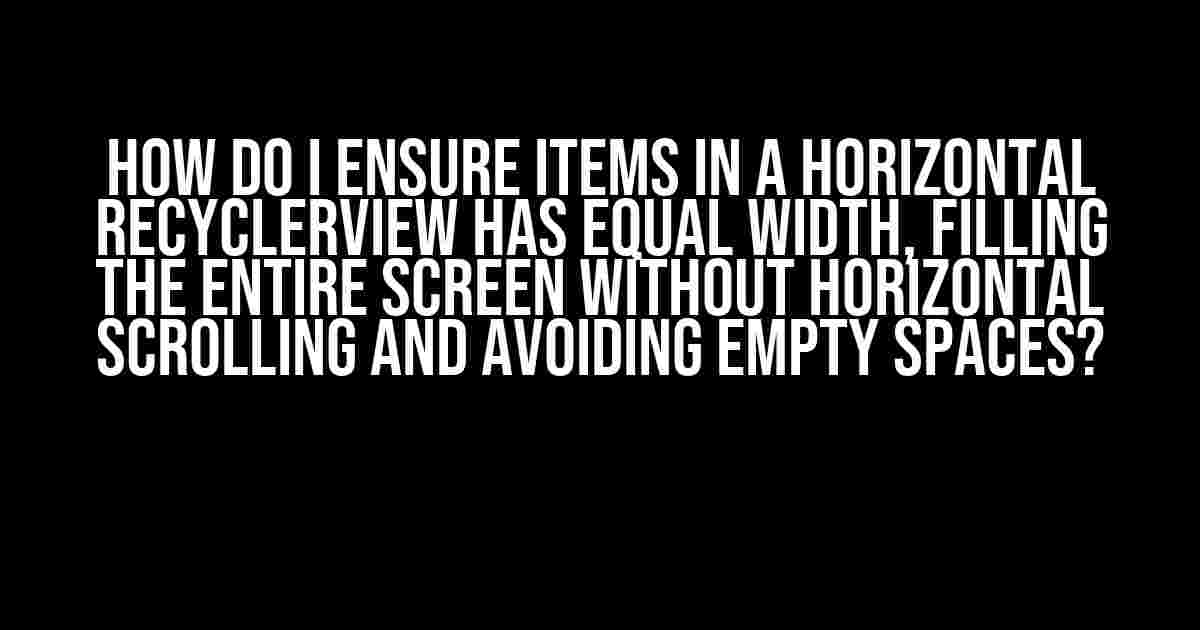When working with RecyclerViews, one of the most common issues developers face is how to make items in a horizontal RecyclerView have equal widths that fill the entire screen, without horizontal scrolling, and avoid empty spaces. It’s a mouthful, isn’t it? Don’t worry, I’ve got you covered! In this article, we’ll dive into the most effective ways to achieve this seemingly impossible feat.
Understanding the Problem
Before we dive into the solutions, let’s take a step back and understand why this problem occurs in the first place. When you create a horizontal RecyclerView, the items are laid out horizontally, and the width of each item is determined by its content. If the items have different widths, the RecyclerView will wrap them to the next line, causing horizontal scrolling. This is not what we want, right?
Why can’t we just set a fixed width?
You might be thinking, “Why can’t I just set a fixed width for each item?” Well, the thing is, a fixed width won’t adapt to different screen sizes and orientations. If you set a fixed width, your app will look great on one device but terrible on another. We want our app to be responsive and adapt to different screen sizes and orientations.
Solution 1: Using layout_width and layout_weight
One way to achieve equal widths for items in a horizontal RecyclerView is by using the `layout_width` and `layout_weight` attributes. Here’s how you can do it:
<LinearLayout
android:layout_width="match_parent"
android:layout_height="wrap_content"
android:orientation="horizontal">
<TextView
android:id="@+id/item1"
android:layout_width="0dp"
android:layout_height="wrap_content"
android:layout_weight="1"
android:text="Item 1"/>
<TextView
android:id="@+id/item2"
android:layout_width="0dp"
android:layout_height="wrap_content"
android:layout_weight="1"
android:text="Item 2"/>
<TextView
android:id="@+id/item3"
android:layout_width="0dp"
android:layout_height="wrap_content"
android:layout_weight="1"
android:text="Item 3"/>
</LinearLayout>
In this example, we’re using a LinearLayout with a horizontal orientation to hold our RecyclerView items. We set the `layout_width` of each item to 0dp and the `layout_weight` to 1. This tells the LinearLayout to distribute the available width equally among the items.
Advantages
- Easy to implement
- Works well with different screen sizes and orientations
Disadvantages
- Doesn’t work well with complex layouts
- Can be slow with large datasets
Solution 2: Using a Custom LayoutManager
Another way to achieve equal widths for items in a horizontal RecyclerView is by creating a custom LayoutManager. This approach requires more code, but it gives you more control over the layout.
public class EqualWidthLayoutManager extends LinearLayoutManager {
public EqualWidthLayoutManager(Context context) {
super(context, LinearLayoutManager.HORIZONTAL, false);
}
@Override
public void onLayoutChildren(RecyclerView.Recycler recycler, RecyclerView.State state) {
super.onLayoutChildren(recycler, state);
int totalWidth = getWidth();
int childCount = getItemCount();
int widthPerItem = totalWidth / childCount;
for (int i = 0; i < childCount; i++) {
View view = recycler.getViewForPosition(i);
addView(view);
measureChildWithMargins(view, 0, 0);
int widthMeasureSpec = MeasureSpec.makeMeasureSpec(widthPerItem, MeasureSpec.EXACTLY);
int heightMeasureSpec = MeasureSpec.makeMeasureSpec(getHeight(), MeasureSpec.EXACTLY);
view.measure(widthMeasureSpec, heightMeasureSpec);
layoutDecorated(view, 0, 0, widthPerItem, getHeight());
}
}
}
In this example, we’re extending the LinearLayoutManager and overriding the `onLayoutChildren` method. We calculate the width of each item by dividing the total width by the number of items. Then, we measure and layout each item with the calculated width.
Advantages
- Works well with complex layouts
- Fast performance with large datasets
Disadvantages
- Requires more code
- Can be difficult to implement
Solution 3: Using a GridLayoutManager
Another approach is to use a GridLayoutManager with a single row. This will automatically distribute the items across the screen, giving them equal widths.
GridLayoutManager layoutManager = new GridLayoutManager(context, 1); recyclerView.setLayoutManager(layoutManager);
In this example, we’re creating a GridLayoutManager with a single row and setting it as the layout manager for our RecyclerView.
Advantages
- Easy to implement
- Works well with different screen sizes and orientations
Disadvantages
- Not suitable for complex layouts
- Can be slow with large datasets
Conclusion
In this article, we’ve explored three different solutions to ensure items in a horizontal RecyclerView have equal widths, filling the entire screen without horizontal scrolling, and avoiding empty spaces. Each solution has its advantages and disadvantages, and the best approach depends on your specific use case.
| Solution | Advantages | Disadvantages |
|---|---|---|
| layout_width and layout_weight | Easy to implement, works well with different screen sizes and orientations | Doesn’t work well with complex layouts, can be slow with large datasets |
| Custom LayoutManager | Works well with complex layouts, fast performance with large datasets | Requires more code, can be difficult to implement |
| GridLayoutManager | Easy to implement, works well with different screen sizes and orientations | Not suitable for complex layouts, can be slow with large datasets |
Remember, the key to achieving equal widths for items in a horizontal RecyclerView is to use a combination of layout attributes, custom layout managers, or grid layouts. With a little creativity and experimentation, you can create a stunning UI that delights your users!
- Try out the different solutions and see which one works best for your use case.
- Experiment with different layout attributes and custom layout managers to achieve the desired effect.
- Remember to test your app on different devices and screen sizes to ensure it looks great everywhere.
Happy coding, and don’t forget to share your experiences and questions in the comments below!
Frequently Asked Question
Finding it tricky to get your RecyclerView items to line up perfectly, filling the entire screen without those pesky horizontal scrolls and empty spaces? Well, you’re in luck because we’ve got the solutions for you!
How do I ensure all items in a horizontal RecyclerView have equal width?
To achieve equal width items in a horizontal RecyclerView, use the `weight` attribute in your item layout XML file. Set `layout_width` to `0dp` and `layout_weight` to `1` for each item. This will distribute the available space evenly among the items.
What’s the secret to filling the entire screen without horizontal scrolling?
To fill the entire screen without horizontal scrolling, set the `RecyclerView`’s `layout_width` to `match_parent` and `layout_height` to `wrap_content`. Then, in your adapter, override the `getItemWidth` method to return the width of each item, calculated based on the screen width and the number of items.
How do I avoid empty spaces between items in a horizontal RecyclerView?
To eliminate empty spaces between items, set the `RecyclerView`’s `layout_margin` and `itemDecoration` to `0dp`. You can also use the `SpacingItemDecoration` class to customize the spacing between items.
What’s the role of LayoutManager in controlling the width of RecyclerView items?
The `LayoutManager` plays a crucial role in controlling the width of RecyclerView items. You can use a custom `LayoutManager` to measure and layout the items according to your requirements. For example, you can use the `GridLayoutManager` with a fixed number of columns to achieve equal width items.
Any tips for handling different screen sizes and orientations?
To handle different screen sizes and orientations, use the `dimens.xml` file to define different width values for different screen sizes. You can also use the `Configuration` class to detect the screen orientation and adjust the item width accordingly. Additionally, consider using a responsive design approach to ensure your layout adapts to different screen sizes and orientations.


